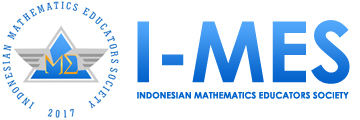Kesulitan Siswa dalam Membuktikan Masalah Kesamaan dan Ketidaksamaan Matematika Menggunakan Induksi Matematika
DOI:
https://doi.org/10.29408/jel.v6i1.1746Keywords:
equality, inequality, mathematical induction, misconceptionAbstract
Mathematical similarities and inequalities are common mathematical statements related to numbers whose truth can be proven by mathematical induction. Proving by mathematical induction involves two main steps, namely the basic step and the induction step. The study of mathematical induction related to similarity and inequality is very important and is still relatively limited in quantity. This study aims to determine whether there are significant differences in students' ability to prove mathematical statements using mathematical induction on mathematical similarities and inequalities problems and identify misconceptions. The study was conducted with a mixed method. A sample of 117 students from two high schools in the city of Singaraja was selected by a random cluster technique to obtain quantitative data. Meanwhile, the research subjects were two students selected based on the misconceptions shown to obtain qualitative data. Quantitative data on the ability to prove the similarity and inequality problems using mathematical induction was collected by written tests and qualitative data on misconceptions were collected by interview. Quantitative data were analyzed by a paired group t-test and by z test for proportions. Meanwhile, qualitative data were analyzed by content analysis of students' works to identify their misconceptions. The results showed that proving the mathematical induction of the inequality problem was more difficult than proving the similarity problem. This difficulty occurs both in the basic step and the induction step. Misconceptions arise due to the fallacy of analogies and interpretations of mathematical notation.References
Andrew, L. (2007). Reasons why students have difficulties with mathematical induction. Retrieved from files.eric.ed.gove/fulltext/ED495959.pdf.
Ashkenazi, Y., & Itzkovitch, E. (2014). Proof by mathematical induction. International Journal of Innovation and Research in Educational Sciences, 1(3), 186–190.
Avital, S., & Libeskind, S. (1978). Mathematical induction in the classroom: Didactical and mathematical issues. Educational Studies in Mathematics, 9(4), 429–438. https://doi.org/10.1007/BF00410588.
Baker, J. (1996). Student’s difficulties with proof by mathematical induction. Paper Presented at Annual Meeting of the American Educational Research Association. New York.
Dogan, H. (2016). Mathematical induction: deductive logic perspective. European Journal of Science and Mathematics Education, 4(3), 315–330.
Ernest, P. (1984). Mathematical induction: A pedagogical discussion. Educational Studies in Mathematics, 15(2), 173–189. https://doi.org/10.1007/BF00305895.
Gruver, J. D. (2010). Growth in students’ conceptions of mathematical induction. Retrieved from All Theses and Dissertations. 2166 website: https://scholarsarchive.byu.edu/etd/2166.
Harel, G. (2002). The development of mathematical induction as a proof scheme: a model for DNR-Based Instruction. In S. R. Campbell & R. Zaskis (Eds.), Learning and Teaching Number Theory: Research in Cognition and Instruction (pp. 185–212). New Jersey: Ablex Publishing Corporation.
Hine, G. (2017). Proof by mathematical induction: Professional practice for secondary teachers. In V. Barker, T. Spencer, & K. Manuel (Eds.), Capital Maths. Proceedings of the 26th Biennial Conference of the Australian Association of Mathematics Teachers (pp. 117–124). Retrieved from https://www.aamt.edu.au/Library/Conference-proceedings.
Kong, C. M. (2003). Mastery of mathematical induction among junior college. The Mathematics Educator, 7(2), 37–54.
Lowenthal, F., & Eisenberg, T. (1992). Mathematical induction in school: an illusion of rigor? School Science and Mathematics, 92(5), 233–238. https://doi.org/10.1111/j.1949-8594.1992.tb15580.x.
Movshovitz-Hadar, N. (1993). Mathematical induction: a focus on the conceptual framework. School Science and Mathematics, 93(8), 408–417. https://doi.org/10.1111/j.1949-8594.1993.tb12271.x.
Öhman, L.-D. (2016). A beautiful proof by induction. Journal of Humanistic Mathematics, 6(1), 73–85. https://doi.org/10.5642/jhummath.201601.06.
Permendikbud nomor 24 tahun 2016 tentang Kompetensi Inti dan Kompetensi Dasar Pelajaran pada Kurikulum 2013 pada Pendidikan Dasar dan Pendidikan Menengah. (2016). Jakarta: Kemdikbud.
Segal, J. (1998). Learners’ difficulties with induction proofs. International Journal of Mathematical Education in Science and Technology, 29(2), 159–177. https://doi.org/10.1080/0020739980290201.
Strauss, A., & Corbin, J. (1990). Basics of qualitative research: Grounded theory procedures and techniques. Thousand Oaks, CA: Sage Publications, Inc.
Supardi. (2016). Aplikasi statistik dalam penelitian konsep statistik yang lebih komprehensip. Jakarta: Change Publication.
Downloads
Additional Files
Published
How to Cite
Issue
Section
License
Authors who publish with the Jurnal Elemen agree to the following terms:
- Authors retain copyright and grant the journal right of first publication with the work simultaneously licensed under Creative Commons Attribution-ShareAlike 4.0 International License (CC BY-SA 4.0).
- Authors are able to enter into separate, additional contractual arrangements for the distribution of the journal's published version of the work (e.g., post it to an institutional repository or publish it in a book), with an acknowledgment of its initial publication in this journal.
- Authors are permitted and encouraged to post their work online (e.g., in institutional repositories or on their website) prior to and during the submission process, as it can lead to productive exchanges, as well as earlier and greater citation of published work.
Jurnal Elemen is licensed under a Creative Commons Attribution-ShareAlike 4.0 International License





